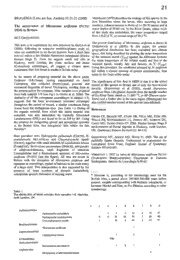
The occurrence 1834) in Britain PDF
Preview The occurrence 1834) in Britain
© Hans Malicky/Austria; download unter www.biologiezentrum.at 21 BRAUERIA (Lunz am See, Austria) 35:21-22 (2008) VERNEAUX (1972) describes the ecology of this species in the Jura Mountains where the larvae, often occurring in large The occurrence of Micrasema setiferum (PlCTET numbers, colonise mosses in flows of+/- 20-70 cm/sec and at water depths of 25-60 cm. In the River Doubs, where much 1834) in Britain. of this study was undertaken, the water temperature ranged from 1.4-21.6 °C, an annual range of 20.2 °C. M.T.GREENWOOD The present distribution of Micrasema setiferum is shown in This note is to supplement the data presented by GREEN et al GREENWOOD et al (2003). In this paper, the present (2006), following an extensive multidisciplinary study of, geographical distribution has been converted into climate what are considered to be fluvial deposits from a short time space, this being described by plotting the mean temperature interval within a late Middle Pleistocene interglacial (Marine of the warmest month (T ) against the difference between max Isotope Stage 9). From the organic sands and silts at the mean temperature of the coldest month and that of the Hackney, north London, the plant, mollusc and insect warmest month, usually July and January, in °C (T ). range (Colcoptera) assemblages, all suggest a climate more Using this procedure, the conditions tolerated by M. setiferum continental than that found in southern Britain today. fall within a climate envelop of greater continentality, than exists in the Trent valley today. In the course of preparing material for the above paper, Professor G.R.Coope, having concentrated on fossil The significance of this find in MIS9 is that it is the oldest Coleoptera, also collected frontoclypeal, pronotal and record of this species in Britain and of only the third known mesonotal fragments of larval Trichoptera, sending these to locality. GREENWOOD et al (2003), record Micrasema the present author for comment. Nine samples were prepared setiferum from Late-glacial deposits from the middle reaches from bulk samples 1-9 (see Fig.3 in GREEN & al. 2006). The of the River Trent, dated ca. 11.600 14C yr BP (Barrow-upon- similarity of all the coleopteran assemblages in samples 1-9, Trent) and a further site in the same region (Hemington) has suggests that the local environment remained unchanged also yielded another record of this species (unpublished). throughout the period of record, a similar conclusion being drawn from the trichopteran taxa (see Table 1.). Dating of References the organic material, from which this insect material was extracted, was also undertaken by Optically Stimulated GREEN CP, BRANCH NP, COOPE GR, FIELD MH, KEEN DH, Luminescence (OSL) and found to be ca 328 ky BP. Using WELLS JM, SCHWENNINGER J-L, PREECE RC, SCHREVE DC, the notation for designating glacial and interglacial episodes CANTI MG, GLEED-OWEN CP. 2006. Marine Isotope Stage 9 in the British Isles, this interglacial falls within the late environments of fluvial deposits at Hackney, north London, Hoxnian*. UK. Quaternary Science Reviews 25: 89-113. Most prevalent were Hydropsy ehe pellucidula (CURTIS), H. GREENWOOD MT, AGNEW MD, WOOD PJ. 2003. The use of contubernalis McLACHLAN and Cheumatopsyche lepida caddisfly fauma (Insecta: Trichoptera) to characterise the (PlCTET), together with small numbers of Lepidostoma hirtum Late-glacial River Trent, England. Journal of Quaternary (FABRICIUS), Sericostoma personatum (SPENCE), Athripsodes Science 187:645-661. cf albifronslbilineatus, small fragments of unknown Limnephilidae and a frontoclypeal apotome of Micrasema VERNEAUX J. 1972 La larve de Micrasema setiferum PlCTET setiferum (PICTET) (see the figure). All taxa are extant in (Trichoptere Brachycentridae) Description et Donnees Britain with the exception of Micrasema setiferum and Ecologiques. Annales de Limnologie 8:49-62. represent an assemblage, typical of habitats in the main artery of a large river. This interpretation is also supported by the presence of large numbers of dryopid (helminthid), coleopteran species, indicative of running water. * Hoxnian is, according to the terminology used for the British Isles, a period about 340.000-300.000 years before present, roughly corresponding with Holstein interglacial, or between Mindel and Riss, or Pre-Illinoian according to other terminology. Table 1. The distribution of larval sclerites from samples 1-9, Hackney, north London, UK. Hydropsychidae Hydropsyche pellucidula 1 4 3 13 4 16 21 Hydropsyche contubernalis 5 2 36 15 54 7 29 49 Cheumatopsyche lepida 1 16 5 44 3 23 51 Brachycentridae *Micrasema setiferum 1 Lepidostomatidae Lepidostoma hirtum 1 1 1 Limnephilidae frag. Sericostomatidae Sericostoma personatum Leptoceridao Athripsodes cf albifrons/bilineatus © Hans Malicky/Austria; download unter www.biologiezentrum.at 22 Micrasema setiferum left thoracic sclerite (fossil) frontoclypeal apotome (fossil) The larva and case, together with a view of the head, showing the patterned frontoclypeal apotome (specimens from Finland) frontoclypeal apotome (fossil
